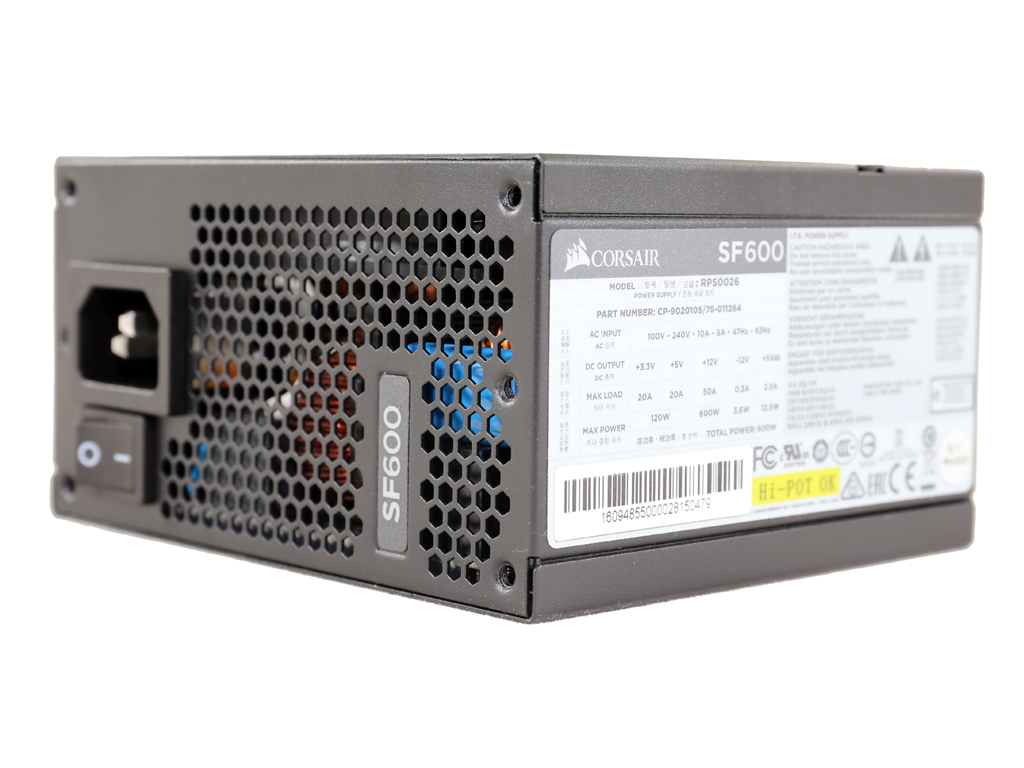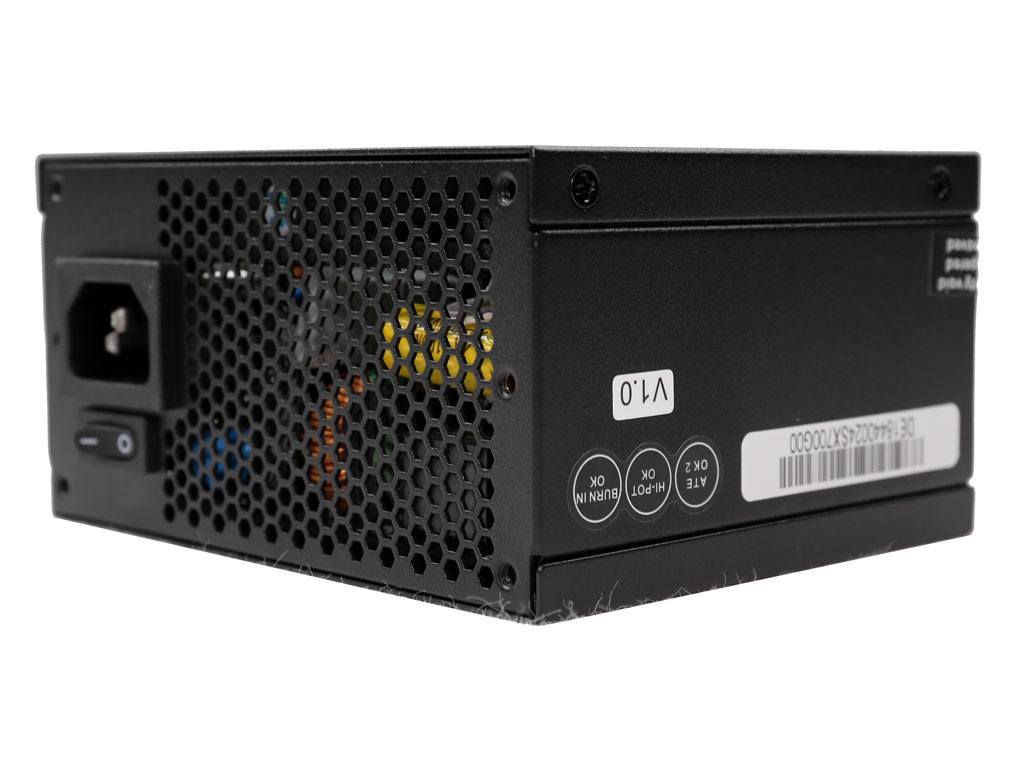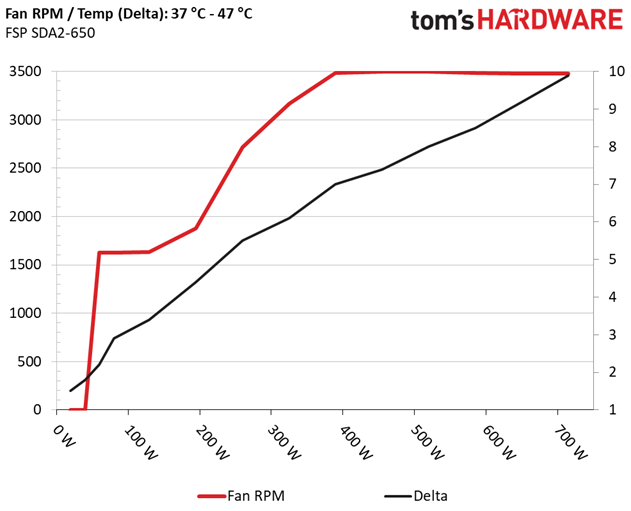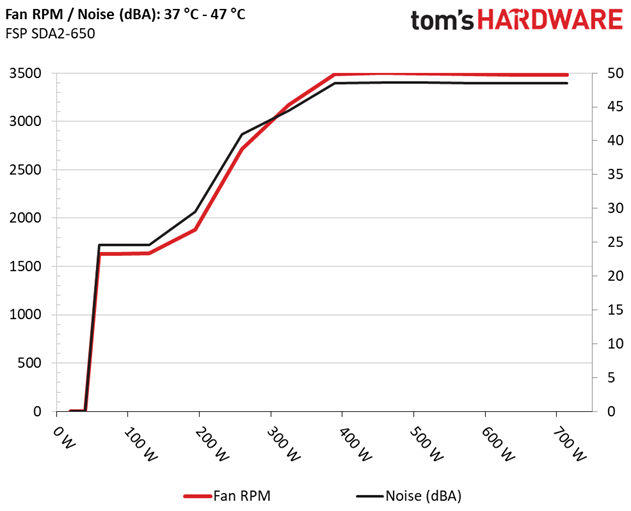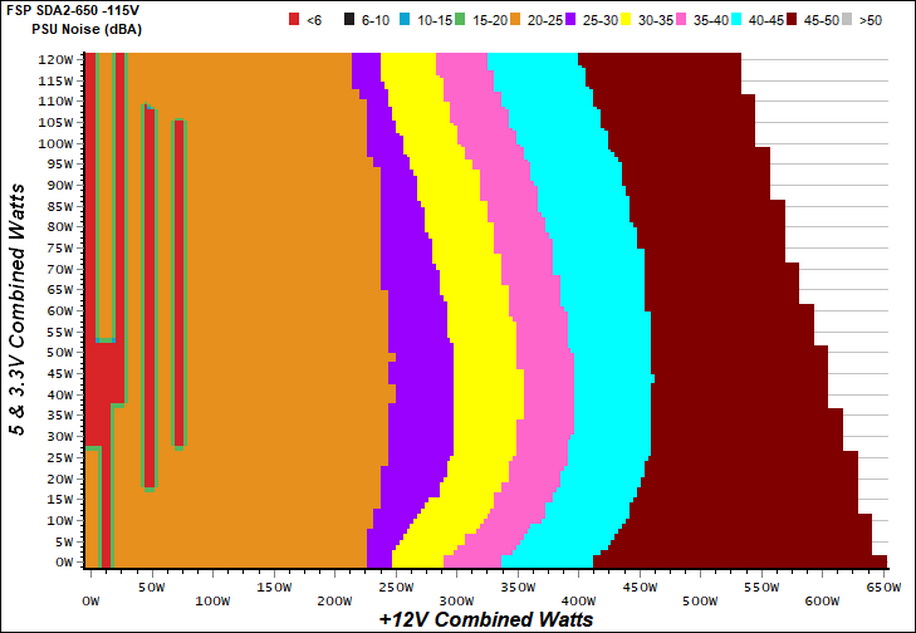FSP Dagger Pro 650W Power Supply Review: Compact and Strong
Why you can trust Tom's Hardware
Load Regulation, Hold-Up Time, Inrush Current, Efficiency and Noise
To learn more about our PSU tests and methodology, please check out How We Test Power Supply Units.
Primary Rails And 5VSB Load Regulation
The following charts show the main rails' voltage values recorded between a range of 40W up to the PSU's maximum specified load, along with the deviation (in percent). Tight regulation is an important consideration every time we review a power supply, because it facilitates constant voltage levels despite varying loads. Tight load regulation also, among other factors, improves the system’s stability, especially under overclocked conditions. And at the same time, it applies less stress to the DC-DC converters that many system components utilize.

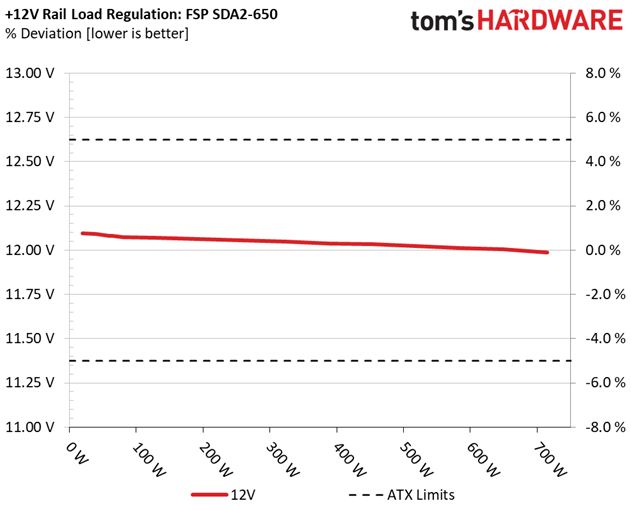
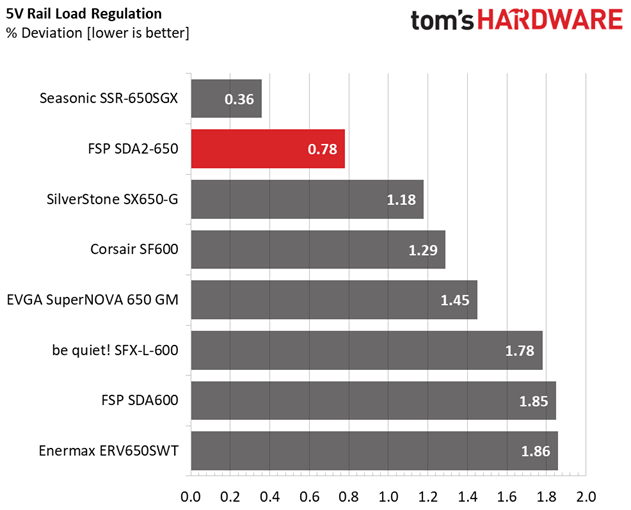
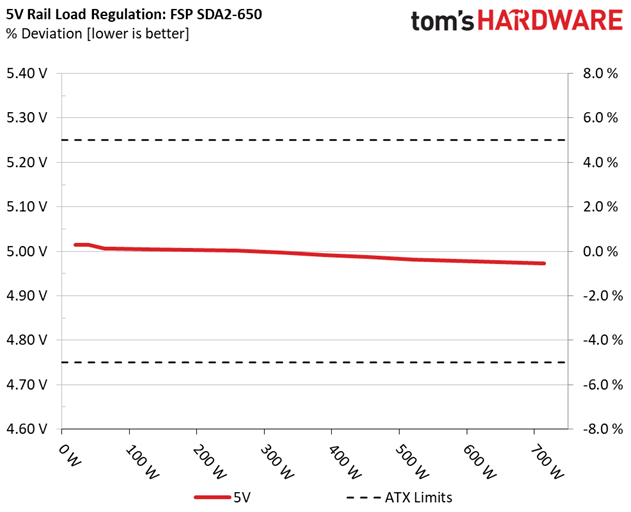


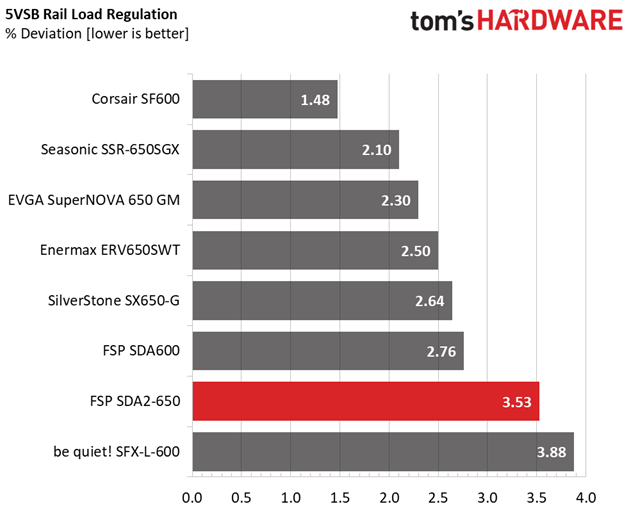
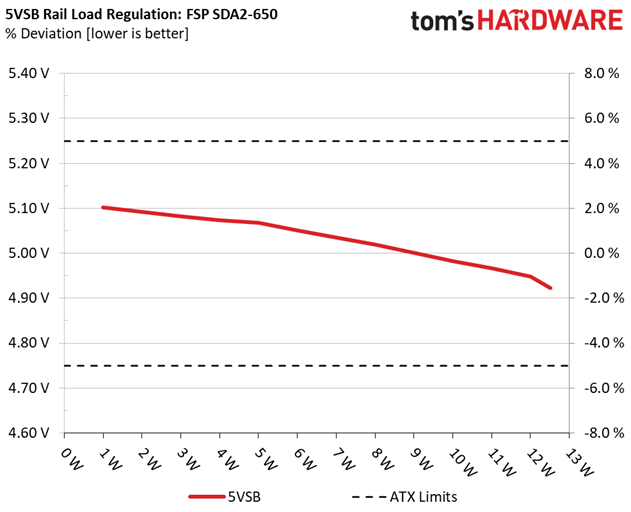
The load regulation is tight, for the standards of the SFX category, on all rails but 5VSB.
Hold-Up Time
Put simply, hold-up time is the amount of time that the system can continue to run without shutting down or rebooting during a power interruption.
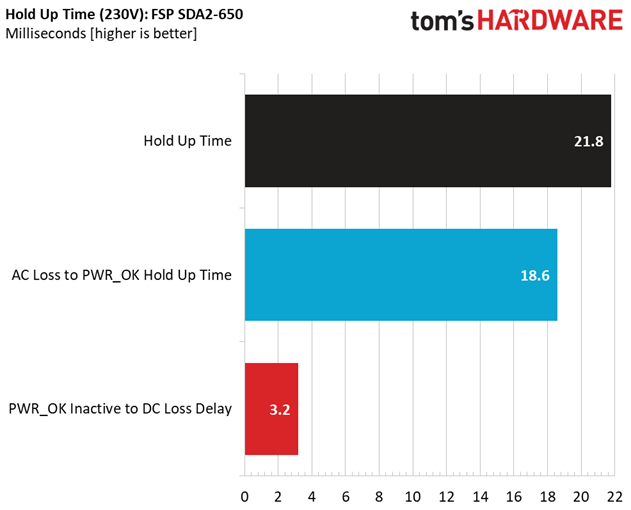
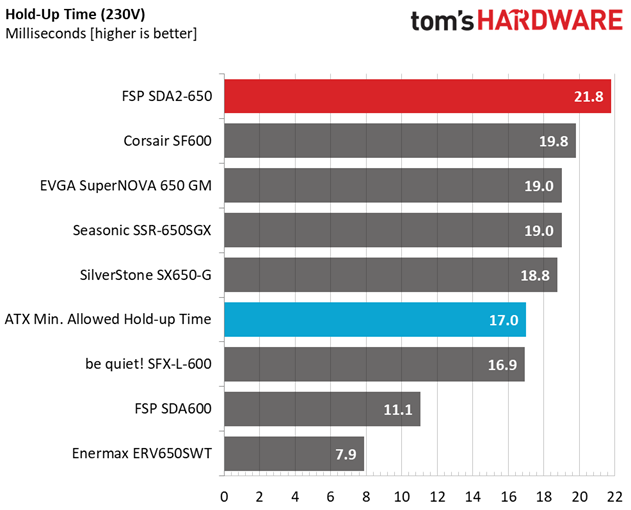
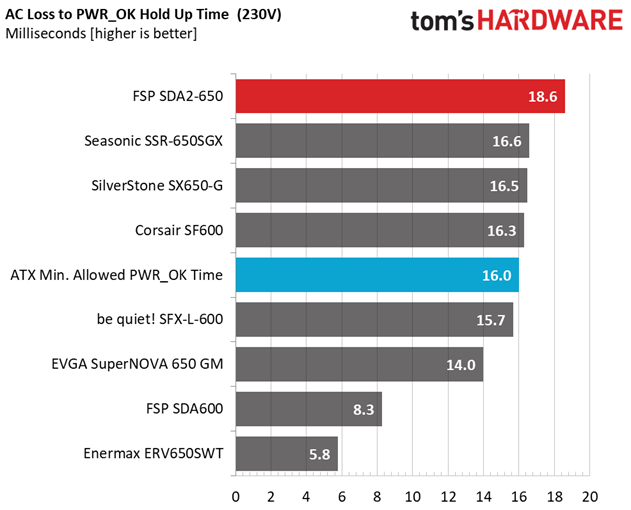

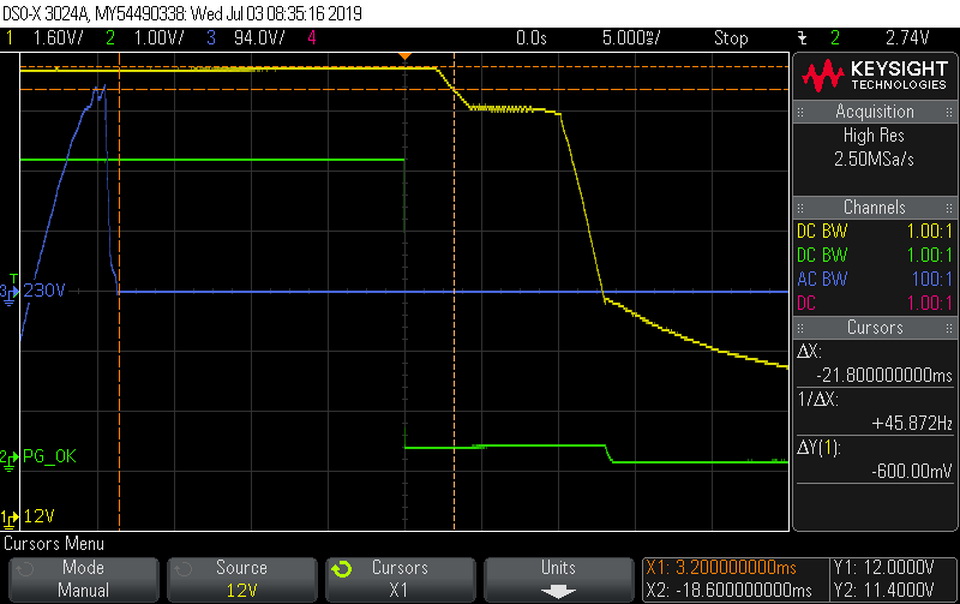
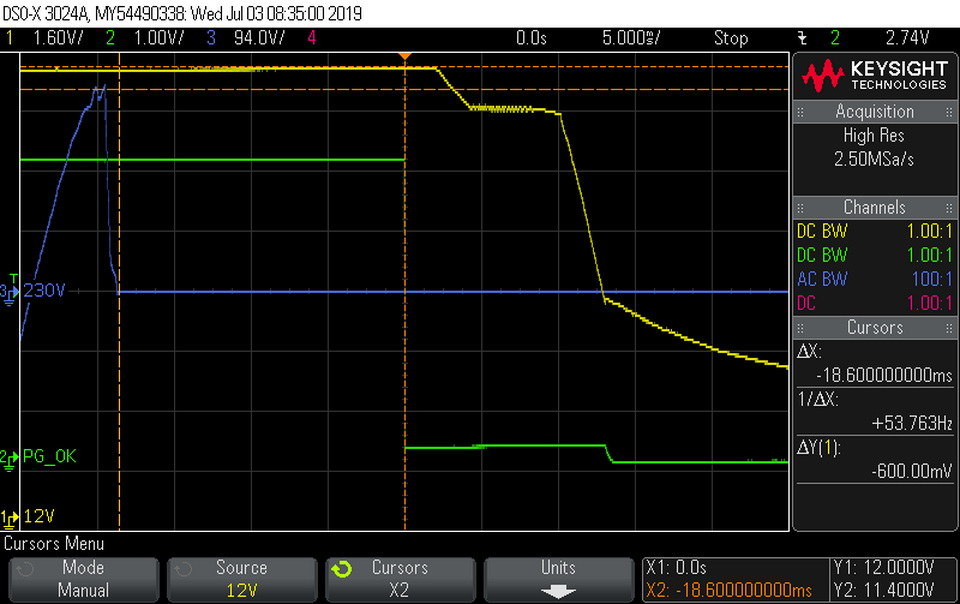
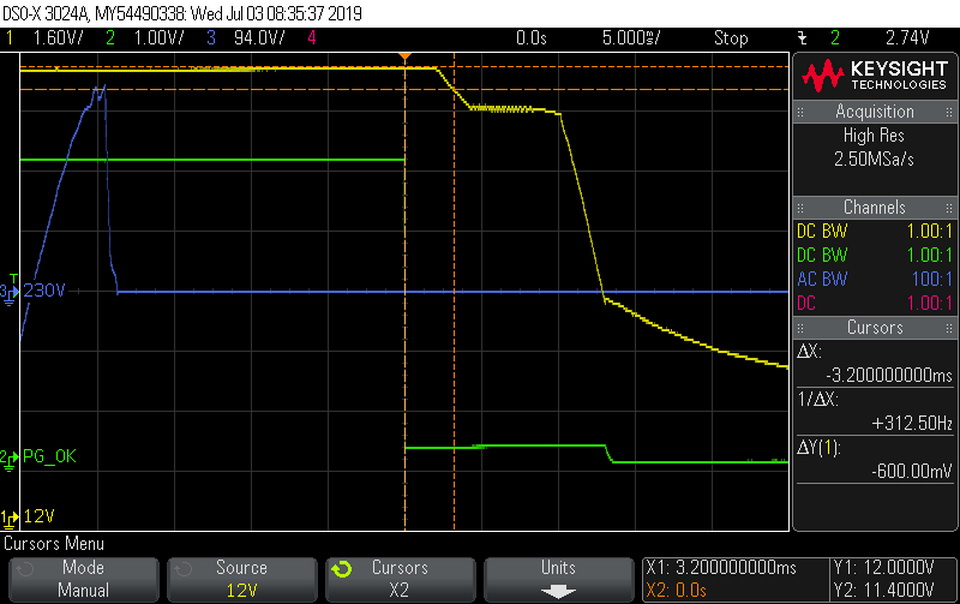
Thanks to the ACRF topology, the hold-up time is quite long, despite the low-capacity bulk cap.
Inrush Current
Inrush current, or switch-on surge, refers to the maximum, instantaneous input current drawn by an electrical device when it is first turned on. A large-enough inrush current can cause circuit breakers and fuses to trip. It can also damage switches, relays, and bridge rectifiers. As a result, the lower the inrush current of a PSU right as it is turned on, the better.
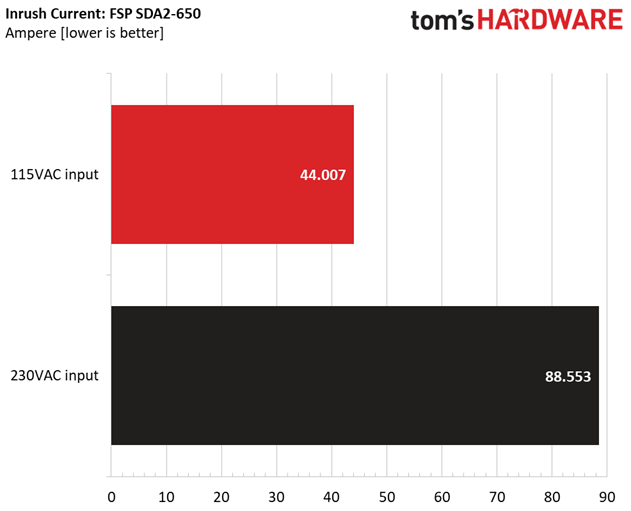
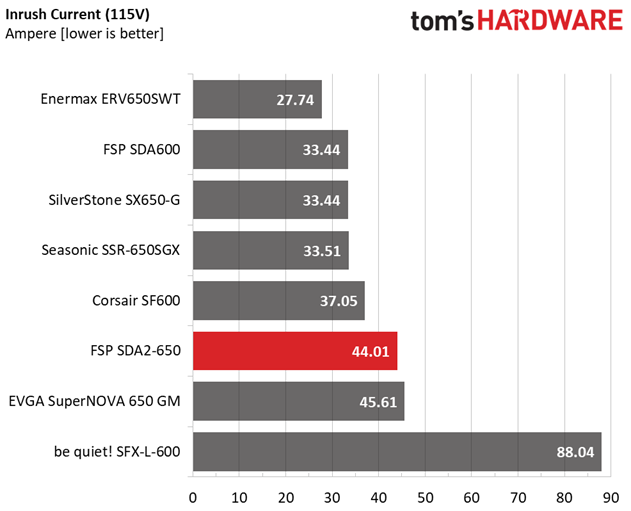
The inrush current here is a bit higher than average.
Get Tom's Hardware's best news and in-depth reviews, straight to your inbox.
10-110% Load Tests
These tests reveal the PSU’s load regulation and efficiency levels under high ambient temperatures. They also show how the fan speed profile behaves under increased operating temperatures.
| Test # | 12V | 5V | 3.3V | 5VSB | DC/AC (Watts) | Efficiency | Fan Speed (RPM) | PSU Noise (dB[A]) | Temps (In/Out) | PF/AC Volts |
|---|---|---|---|---|---|---|---|---|---|---|
| 1 | 3.590A | 1.998A | 1.990A | 0.987A | 64.972 | 83.988% | 1628 | 24.6 | 40.14°C | 0.957 |
| 12.079V | 5.006V | 3.319V | 5.068V | 77.359 | 43.02°C | 115.12V | ||||
| 2 | 8.166A | 2.999A | 2.984A | 1.188A | 129.469 | 88.351% | 1635 | 24.6 | 40.82°C | 0.980 |
| 12.070V | 5.004V | 3.317V | 5.051V | 146.539 | 44.26°C | 115.12V | ||||
| 3 | 13.143A | 3.499A | 3.469A | 1.390A | 194.551 | 89.654% | 1879 | 29.5 | 41.28°C | 0.989 |
| 12.063V | 5.003V | 3.316V | 5.035V | 217.001 | 45.63°C | 115.12V | ||||
| 4 | 18.129A | 4.002A | 3.984A | 1.594A | 259.777 | 89.811% | 2715 | 40.9 | 41.73°C | 0.994 |
| 12.056V | 5.001V | 3.313V | 5.019V | 289.250 | 47.21°C | 115.12V | ||||
| 5 | 22.788A | 5.006A | 4.985A | 1.800A | 325.067 | 89.553% | 3169 | 44.4 | 42.19°C | 0.997 |
| 12.048V | 4.997V | 3.310V | 5.001V | 362.989 | 48.27°C | 115.12V | ||||
| 6 | 27.396A | 6.013A | 5.990A | 2.007A | 389.614 | 88.960% | 3488 | 48.5 | 42.49°C | 0.998 |
| 12.038V | 4.992V | 3.306V | 4.983V | 437.966 | 49.52°C | 115.12V | ||||
| 7 | 32.064A | 7.021A | 6.998A | 2.216A | 454.913 | 88.449% | 3498 | 48.6 | 43.53°C | 0.998 |
| 12.032V | 4.987V | 3.301V | 4.966V | 514.325 | 50.97°C | 115.12V | ||||
| 8 | 36.746A | 8.034A | 8.008A | 2.427A | 520.225 | 87.739% | 3495 | 48.6 | 43.62°C | 0.998 |
| 12.023V | 4.981V | 3.297V | 4.948V | 592.924 | 51.63°C | 115.11V | ||||
| 9 | 41.843A | 8.541A | 8.497A | 2.432A | 585.140 | 86.967% | 3486 | 48.5 | 44.43°C | 0.998 |
| 12.012V | 4.978V | 3.295V | 4.937V | 672.829 | 52.88°C | 115.11V | ||||
| 10 | 46.872A | 9.050A | 9.021A | 2.541A | 649.880 | 86.033% | 3480 | 48.5 | 45.36°C | 0.998 |
| 12.004V | 4.975V | 3.292V | 4.922V | 755.381 | 54.54°C | 115.11V | ||||
| 11 | 52.341A | 9.053A | 9.025A | 2.547A | 714.693 | 84.986% | 3480 | 48.5 | 46.54°C | 0.998 |
| 11.988V | 4.973V | 3.291V | 4.911V | 840.953 | 56.42°C | 115.10V | ||||
| CL1 | 0.150A | 14.004A | 14.001A | 0.000A | 116.914 | 81.620% | 3304 | 45.6 | 42.52°C | 0.980 |
| 12.076V | 4.953V | 3.267V | 5.073V | 143.241 | 48.40°C | 115.13V | ||||
| CL2 | 54.020A | 1.004A | 1.002A | 1.000A | 661.468 | 86.680% | 3484 | 48.5 | 45.52°C | 0.998 |
| 11.998V | 5.005V | 3.316V | 4.988V | 763.119 | 54.87°C | 115.11V |
Under high temperatures and with 50% of the unit's max-rated-output and above loads, the fan is annoyingly loud. FSP's engineers were conservative, so they opted for an aggressive fan profile, to increase reliability.
20-80W Load Tests
In the following tests, we measure the PSU's efficiency at loads significantly lower than 10% of its maximum capacity (the lowest load the 80 PLUS standard measures). This is important for representing when a PC is idle with power-saving features turned on.
| Test # | 12V | 5V | 3.3V | 5VSB | DC/AC (Watts) | Efficiency | Fan Speed (RPM) | PSU Noise (dB[A]) | PF/AC Volts |
|---|---|---|---|---|---|---|---|---|---|
| 1 | 1.202A | 0.500A | 0.481A | 0.196A | 19.646 | 70.406% | 0 | <6.0 | 0.887 |
| 12.095V | 5.014V | 3.326V | 5.102V | 27.904 | 115.12V | ||||
| 2 | 2.462A | 0.998A | 0.993A | 0.393A | 40.076 | 80.841% | 0 | <6.0 | 0.926 |
| 12.091V | 5.014V | 3.325V | 5.092V | 49.574 | 115.13V | ||||
| 3 | 3.654A | 1.499A | 1.475A | 0.591A | 59.557 | 84.101% | 1626 | 24.6 | 0.952 |
| 12.082V | 5.008V | 3.321V | 5.082V | 70.816 | 115.13V | ||||
| 4 | 4.915A | 1.999A | 1.987A | 0.789A | 79.953 | 86.082% | 1627 | 24.6 | 0.961 |
| 12.075V | 5.006V | 3.319V | 5.073V | 92.880 | 115.12V |
In only two out of the four light load tests does the fan remain off. The sad part is that once the fan engages, its minimum speed is pretty high. The minimum fan speed is close to 1000 RPM, so FSP could set its starting speed at a much lower level.
Efficiency
Next, we plotted a chart showing the PSU’s efficiency at low loads, and loads from 10 to 110% of its maximum-rated capacity. The higher a PSU’s efficiency, the less energy goes wasted, leading to a reduced carbon footprint, besides lower electricity bills.
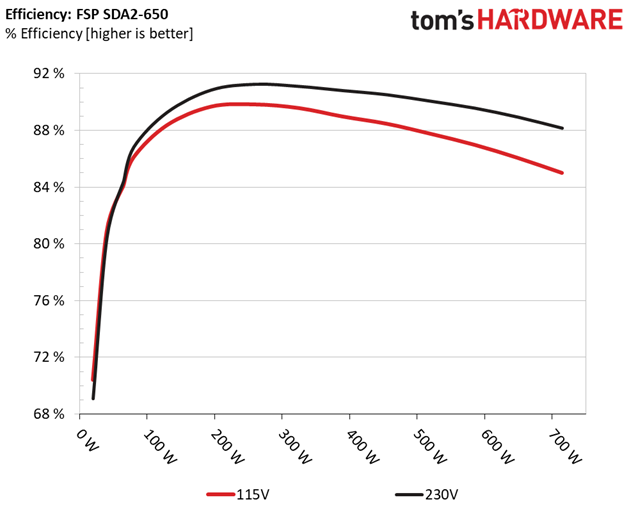

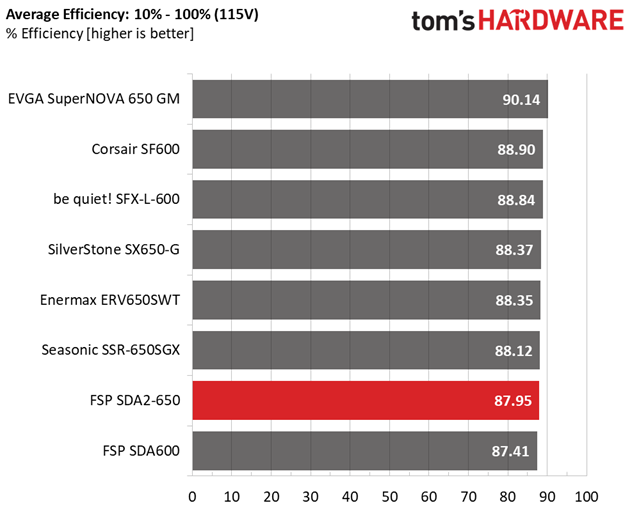
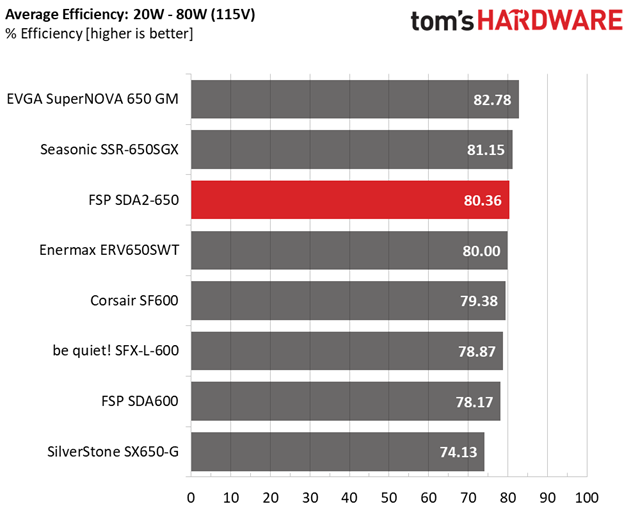
The average efficiency number at normal loads is higher than the SDA600's, but still not high enough to effectively meet the competition. Under light loads, the situation is better.
5VSB Efficiency
| Test # | 5VSB | DC/AC (Watts) | Efficiency | PF/AC Volts |
|---|---|---|---|---|
| 1 | 0.100A | 0.511 | 67.593% | 0.128 |
| 5.110V | 0.756 | 115.11V | ||
| 2 | 0.250A | 1.277 | 72.392% | 0.240 |
| 5.105V | 1.764 | 115.11V | ||
| 3 | 0.550A | 2.803 | 73.783% | 0.345 |
| 5.095V | 3.799 | 115.12V | ||
| 4 | 1.000A | 5.081 | 73.045% | 0.409 |
| 5.080V | 6.956 | 115.12V | ||
| 5 | 1.500A | 7.595 | 72.278% | 0.442 |
| 5.063V | 10.508 | 115.12V | ||
| 6 | 2.501A | 12.573 | 70.127% | 0.476 |
| 5.028V | 17.929 | 115.12V |

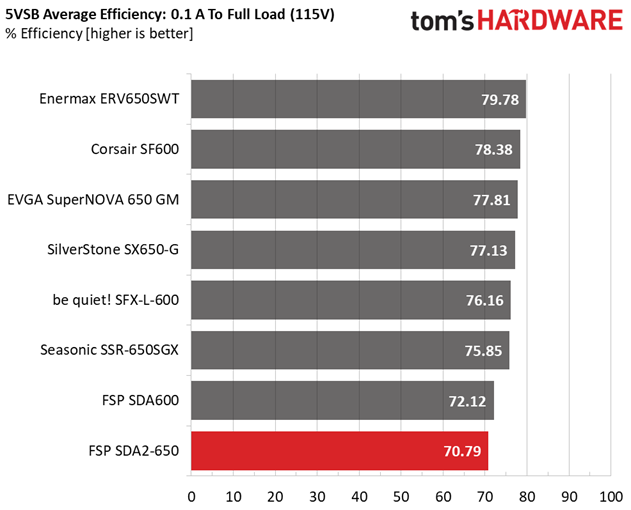
It is shame to see such a low-efficiency 5VSB rail in a new power supply. It makes us wonder why FSP didn't use one of the advanced 5VSB circuits the company has in its portfolio.
Power Consumption In Idle And Standby
| Mode | 12V | 5V | 3.3V | 5VSB | Watts | PF/AC Volts |
|---|---|---|---|---|---|---|
| Idle | 12.098V | 5.015V | 3.326V | 5.113V | 6.859 | 0.656 |
| 115.2V | ||||||
| Standby | 0.125 | 0.023 | ||||
| 115.2V |

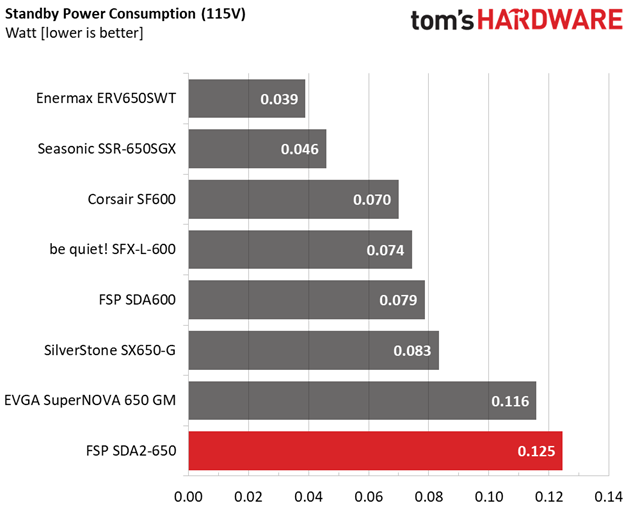
Fan RPM, Delta Temperature, And Output Noise
All results are obtained between an ambient temperature of 37 to 47 degrees Celsius (98.6 to 116.6 degrees Fahrenheit).
The following results were obtained at 30 to 32 degrees Celsius (86 to 89.6 degrees Fahrenheit) ambient temperature.
The semi-passive operation doesn't last long, once you push the minor rails hard. With up to 240W loads, the PSU's fan is within the 20-25 dB(A) zone, which is quite enough but the transition from passive to active operation could be smoother. With higher than 410W loads, the PSU's fan gets loud.
MORE: Best Power Supplies
MORE: How We Test Power Supplies
MORE: All Power Supply Content
Current page: Load Regulation, Hold-Up Time, Inrush Current, Efficiency and Noise
Prev Page Specifications and Part Analysis Next Page Protection Features, DC Power Sequencing, Cross-Load Tests and Infrared Images
Aris Mpitziopoulos is a contributing editor at Tom's Hardware, covering PSUs.

